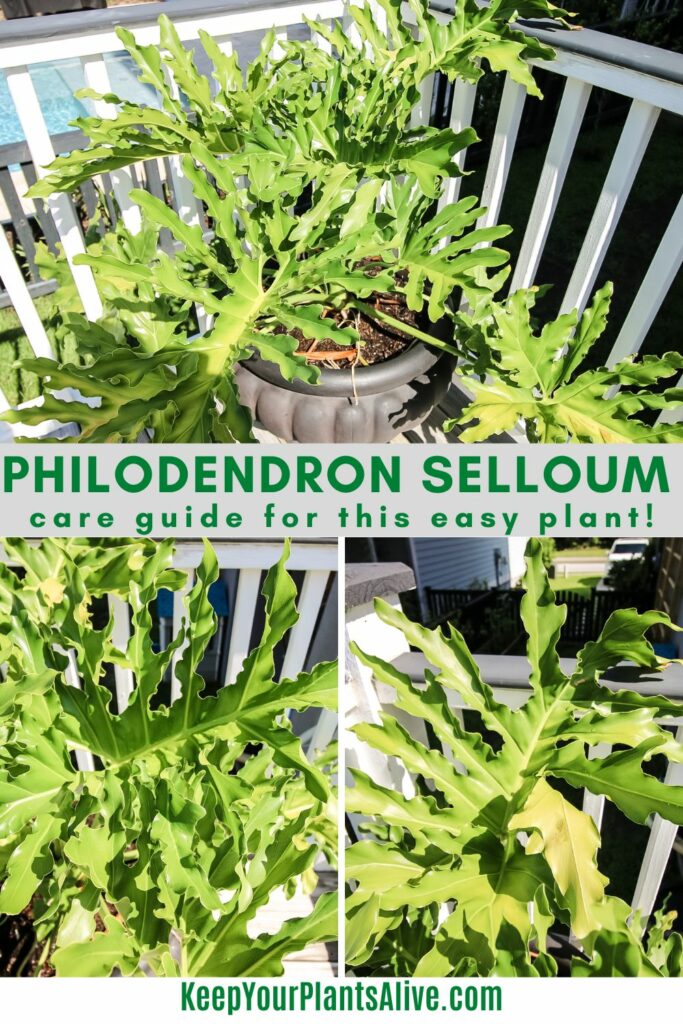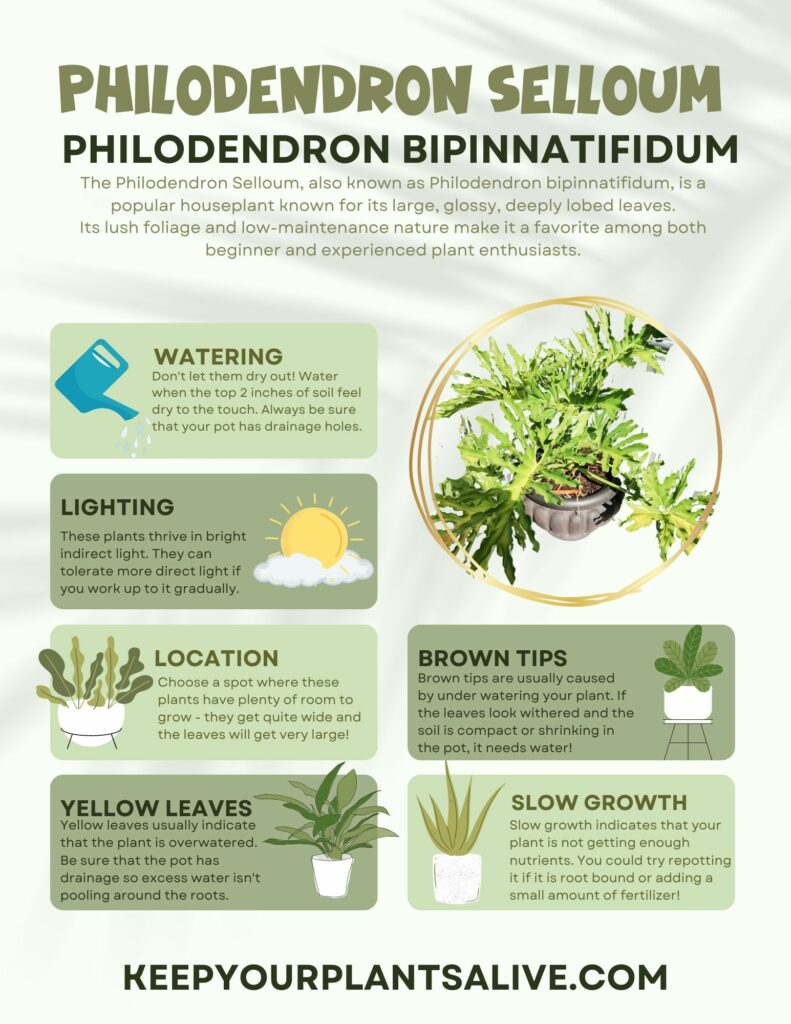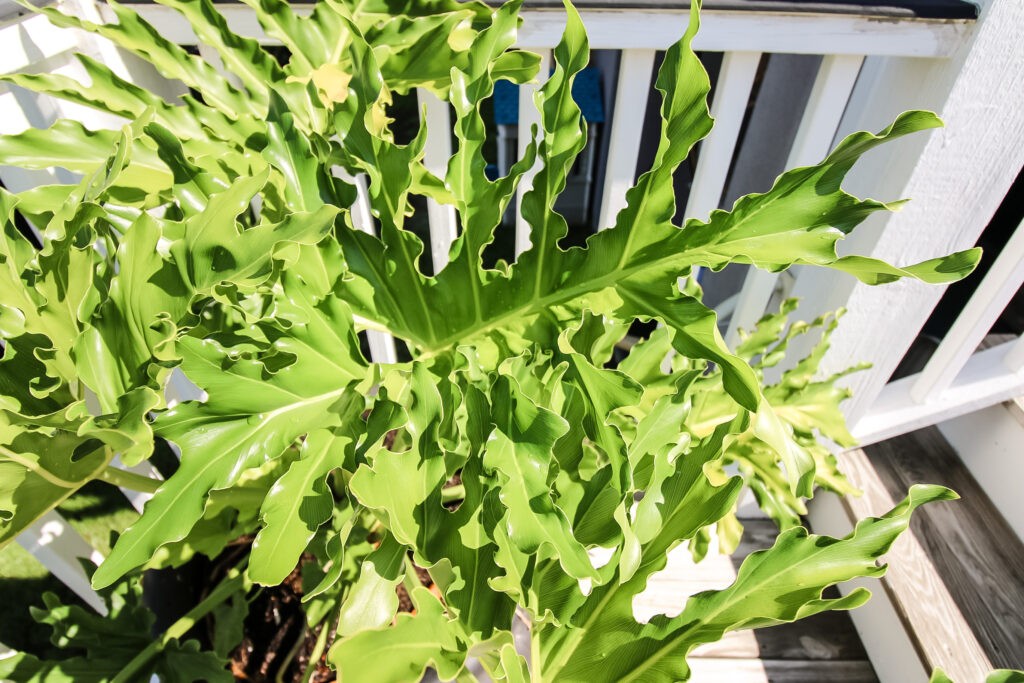Want to add a beautiful tropical plant to your collection? Here is my complete philodendron selloum care guide!
Living in Charleston, South Carolina, we are sort of on the border of where tropical plants will live and thrive outdoors.
There are a few plants that I've had a lot of luck with keeping outdoors, even in the winter.
On the coldest nights, we typically bring our potted plants inside our garage, cover them with a cloth, and they almost always do OK.
Today I want to talk about one of these plants that I keep potted outdoors that has lasted for years and years, even with a few colder winter nights.
I am talking about the Philodendron Selloum plant!
Want to add a Philodendron Selloum to your houseplant collection? Known for its stunning beauty and easy care, this tropical gem is the perfect addition to any indoor jungle.
In this care guide, we'll delve into everything you need to know to keep your Philodendron Selloum thriving and lush.
From watering and lighting needs to propagation tips and troubleshooting, we've got you covered!

Philodendron Selloum PDF care guide
Join the (free!) KeepYourPlantsAlive+ community to access this exclusive printable plant care guide! Once you sign up, you can right click & save the JPG care guide. Or keep scrolling for more!

What is Philodendron Selloum?
The Philodendron Selloum, also known as Philodendron bipinnatifidum, is a popular houseplant known for its large, glossy, deeply lobed leaves.
Its lush foliage and low-maintenance nature make it a favorite among both beginner and experienced plant enthusiasts.
Other Names for Philodendron Selloum Include:
- Tree Philodendron
- Lacy Tree Philodendron
- Cut-Leaf Philodendron
I love these plants, because they grow really quickly, they grow wide, and the leaves are huge and sprawling. They have a really unique, almost rippled texture, and it just adds a lovely addition to any yard.
Philodendron Selloum Origins
Native to the rainforests of South America, particularly Brazil and Paraguay, Philodendron Selloum thrives in tropical climates with warm temperatures and high humidity.
Is Philodendron Selloum Rare?
While Philodendron Selloum is popular in the houseplant community, it is not considered rare and is widely available in nurseries and garden centers.
Is Philodendron Selloum Toxic?
Yes, Philodendron Selloum is toxic to humans and pets if ingested. It contains calcium oxalate crystals that can cause irritation and discomfort when consumed.
Philodendron selloum vs monstera deliciosa
For some reason when you search for a split leaf philodendron him, you get a lot of pictures of a Monstera Delicioso.
The same Monstera plant pops up a lot when you search Swiss cheese plant, and it's not what I would call a Swiss cheese plant either.
Philodendron selloum is the true split leaf philodendron. Monstera isn't even a philodendron. It does have split leaves, I guess!

Philodendron Selloum Care Guide
Here is a guide to the watering, lighting, and other care needs of your Philodendron Selloum plant.
Philodendron Selloum Watering
Water your plant when the top inch of the soil feels dry to the touch. These are tropical plants and do not like to dry out fully in between watering.
Avoid overwatering to prevent root rot.
Especially if you are keeping your plant outdoors where it will get rained on, it is important to have drainage holes so that the pot doesn't flood and rot the roots of your plant.
Check out our guide on drilling drainage holes in pots to ensure proper water drainage for your Philodendron Selloum.
Should I Mist My Philodendron Selloum?
Misting is not essential for Philodendron Selloum, as it thrives in average household humidity. However, misting can be beneficial in dry indoor environments or during hot weather.
If you decide to keep this plant indoors during the winter, and I are running the heat, you were going to want to give it humidity in someway. This could be by misting, running a humidifier, clustering it with other plants, or using a pebble tray.

Philodendron Selloum Lighting Needs
Place your Philodendron Selloum in bright, indirect light for optimal growth. Avoid direct sunlight, as it can lead to leaf burn.
Indoors, a spot near a north or east-facing window is ideal.
Outdoors, they do great in bright light that's shaded by an overhang or tree.
Can I Keep Philodendron Selloum Outdoors?
Philodendron Selloum will thrive outdoors during the warmer months, as long as it is protected from direct sunlight and strong winds.
Actually, I'm not sure how people keep these plants indoors all year long just because they grow so quickly and so wide. I highly suggest you keep these plants outside!
Philodendron Selloum Soil + Potting
Use a well-draining potting mix for your Philodendron Selloum. It prefers slightly moist soil but can tolerate short periods of dryness.
Repot your plant every 2-3 years, but it doesn't mind being slightly root-bound.
I suggest choosing a pot that has a little bit of weight to it. As I've mentioned, these plants can grow pretty wide, and if they are in a lightweight plastic pot, can tend to tip over a lot. Instead, pick something ceramic or just a heavier plastic pot
Does Philodendron Selloum Need a Moss Pole?
Philodendron Selloum can benefit from a moss pole for support as it grows taller. Here's our guide on how to make a moss pole for your plant!
Alternatively, you can stake this plant or give it a trellis. This will help to contain it and keep it from being quite so wide.
Philodendron Selloum Fertilization
Feed your Philodendron Selloum with a balanced liquid fertilizer during the growing season (spring and summer) every 2-4 weeks. Reduce or stop fertilization during the dormant period (fall and winter).

How to Propagate Philodendron Selloum
You can take stem cuttings of your Philodendron or divide it when you repot it, if it gets too large for the pot.
Propagating Philodendron Selloum in water is incredibly easy! Follow these steps:
- Identify a healthy branch with new growth.
- Snip the branch with sharp scissors.
- Remove any lower leaves.
- Place the cutting in water, ensuring at least 1 - preferably 2 - nodes are submerged.
- Change the water weekly and top off as necessary.
- Roots should form in 2-4 weeks.
- Once the roots are 2-3 inches long, plant the cutting in soil.
Troubleshooting Philodendron Selloum
Water your Philodendron Selloum when the top inch of the soil feels dry to the touch. Typically, this means watering once every 1-2 weeks, but adjust the frequency based on your home's humidity and light conditions.
No, Philodendron Selloum prefers bright, indirect light. Direct sunlight can cause leaf burn and damage the plant.
Yes, Philodendron Selloum is toxic to pets if ingested. Keep it out of reach of curious pets to prevent any health issues.
If the leaf edges or tips turn brown and crispy, it may indicate low humidity. Consider misting the plant, using a humidifier, or placing a tray of water nearby to increase humidity levels.
Pruning is not necessary, but it can help maintain a bushy and attractive shape. Trim any yellowing or dead leaves, as well as leggy stems, to encourage new growth.
Ideally, use filtered or rain water to avoid mineral buildup in the soil. If tap water is your only option, allow it to sit out overnight to allow chlorine to dissipate.
Philodendron Selloum prefers temperatures between 65°F to 85°F (18°C to 29°C). Avoid exposing it to cold drafts or temperatures below 55°F (13°C).
Under ideal conditions, Philodendron Selloum can grow relatively fast, producing new leaves every few weeks during the growing season.
Yellow leaves can be caused by overwatering, underwatering, or exposure to direct sunlight. Assess your watering routine and light conditions to determine the cause and adjust accordingly.
Have a question about your Philodendron Selloum?
Thanks for reading!


Hey there, I'm Morgan, a houseplant enthusiast from sunny Charleston, South Carolina. Growing up surrounded by my mom's lush orchids and African violets, I discovered the magic of bringing nature indoors. Thanks to the pandemic, I delved deeper into houseplants, discovering their power to uplift moods and transform spaces. I'm here to spill all my secrets, helping you pick the perfect houseplant - and make it happy. Let's keep your plants alive, together! 😊
